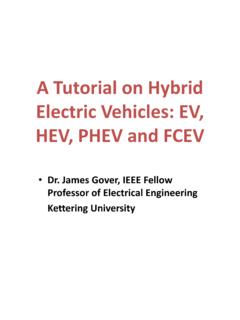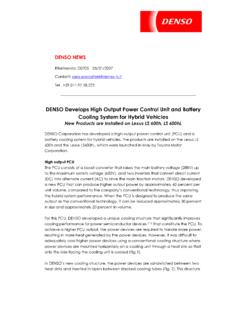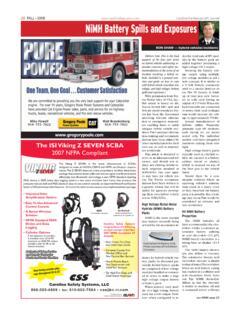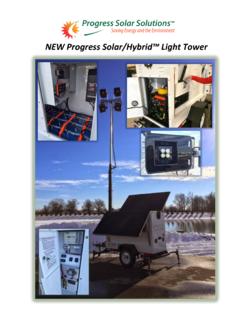Transcription of TOYOTA HYBRID SYSTEM - EV WORLD.COM
1 TOYOTA HYBRID SYSTEM . Contents Introduction .. 1. What is a HYBRID SYSTEM ? .. 2. Three Objectives of THS II Development .. 4. How the THS II SYSTEM Works .. 5. High-voltage systems motor and generator .. 6. Power Control Unit, Battery and Regenerative Braking SYSTEM .. 8. HYBRID Transmission .. 10. Engine .. 12. SYSTEM Control .. 14. Output Enhancement .. 18. In-house Development and Production .. 19. Specifications of New HYBRID SYSTEM .. 20. The new Prius features THS II, TOYOTA 's next-generation hibrid technology Introduction New levels of environmental & power performance compatibility based on the concept of HYBRID Synergy Drive At the 2003 New York Auto Show, TMC President Cho unveiled the all-new Prius with THS II, a HYBRID Synergy Drive concept that delivers both higher power and greater fuel economy than the previous Prius.
2 In search of the ultimate eco-car TOYOTA 's mission has always been to provide clean and safe products. Thus, the company has positioned the environment as one of its most important issues and has been working toward creating a prosperous society and a world that is comfortable to live in. With this goal in mind, TOYOTA has been actively developing various new technologies from the perspective of achieving energy security and diversifying energy sources, which is necessitated by the dwindling supply of petroleum resources. For example, in motive power sources for automobiles alone, we have been continuously improving conventional engines and have developed and commercialized lean-burn gasoline engines, direct injection gasoline engines and common rail direct-injection diesel engines, TOYOTA HYBRID SYSTEM II (THS II).
3 Etc. We have also been modifying engines so that they can use alternative fuels, such as compressed natural gas (CNG), instead of gasoline or light oil, and have been installing these engines in commercially sold vehicles. TOYOTA has also developed and has been marketing electric vehicles (EV) that use motors for the driving source;. HYBRID vehicles (HV) that combine an engine and a motor, fusing the advantages of these two power sources; fuel cell HYBRID vehicles (FCHV) that use fuel cells (FC) to generate electricity based on a chemical reaction between hydrogen and the oxygen in the air and that supply this electricity to electric motors to produce driving power. In January 1997, TOYOTA declared the start of the TOYOTA Eco Project.
4 As part of this effort, TOYOTA decided to tackle the international challenge of reducing CO2 emissions in order to prevent global warming and accelerated the development of a HYBRID vehicle with the goal of achieving twice the fuel efficiency of conventional vehicles. Then, in March of the same year, TOYOTA announced the completion of a new power train called the TOYOTA HYBRID SYSTEM (THS) for use in passenger vehicles. This power train combines a gasoline engine and an electric motor, and because it does not require external charging, as do existing electric vehicles, it works within existing infrastructures such as fueling facilities. This SYSTEM also achieves nearly twice the fuel efficiency of conventional gasoline engines.
5 THS was installed in the passenger vehicle Prius, which was introduced in December 1997 in the Japanese market as the first mass-produced HYBRID passenger vehicle in the world. In 2000, overseas marketing of the Prius began. The Prius has gained a reputation as a highly innovative vehicle, and its cumulative worldwide sales have exceeded 110,000 units. Meanwhile, THS has continued to evolve, and in 2001, THS-C, which combines THS with CVT (continuously variable transmission), was installed in the Estima HYBRID minivan and THS-M (a mild HYBRID SYSTEM ) was This is all part of our search for the ultimate eco-car. installed in the Crown, luxury sedan, both for the Japanese market thereby contributing greatly to innovations in the automobiles of the 21st century.
6 Building on the ecology-focused THS, TOYOTA has developed the concept of HYBRID Synergy Drive. Based on this concept, TOYOTA has developed a new-generation TOYOTA HYBRID SYSTEM called THS II, which achieves high levels of compatibility between environmental performance and power by increasing the motor output by times, greatly boosting the power supply voltage and achieving significant advances in the control SYSTEM , aiming for synergy between motor power and engine power. TOYOTA has positioned HYBRID technology as its key technology. Beginning with the development of EVs and through the commercialization of HVs and FCHVs, its continued efforts have now culminated in the development of THS II. TOYOTA will * Direct Injection 4-stroke Gasoline Engine ** Variable Valve Timing with Intelligence continue to endeavor to make technical advances in this area.
7 -1- What is a HYBRID SYSTEM ? Fusion between an internal combustion engine and electric motor achieving different functions through different power combinations Automobile HYBRID systems combine two motive power sources, such as an internal combustion engine and an electric motor, to take advantage of the benefits provided by these power sources while compensating for each other's shortcomings, resulting in highly efficient driving performance. Although HYBRID systems use an electric motor, they do not require external charging, as do electric vehicles. 3 types of HYBRID Systems Drive power Electric power The following three major types of HYBRID systems are being used in the HYBRID vehicles currently on the market: Battery 1) SERIES HYBRID SYSTEM Inverter The engine drives a generator, and an electric motor uses this generated electricity to drive the Engine Motor wheels.
8 This is called a series HYBRID SYSTEM Generator because the power flows to the wheels in series, , the engine power and the motor power are in Drive wheels Reduction series. A series HYBRID SYSTEM can run a small- gear output engine in the efficient operating region relatively steadily, generate and supply electricity Series HYBRID SYSTEM to the electric motor and efficiently charge the battery. It has two motors a generator (which has the same structure as an electric motor) and an Drive power Electric power electric motor. This SYSTEM is being used in the Coaster HYBRID . Battery 2) PARALLEL HYBRID SYSTEM . In a parallel HYBRID SYSTEM , both the engine Inverter and the electric motor drive the wheels, and the Transmission drive power from these two sources can be utilized Engine Motor/generator according to the prevailing conditions.
9 This is called a parallel HYBRID SYSTEM because the power flows to the wheels in parallel. In this SYSTEM , the battery Drive wheels Reduction is charged by switching the electric motor to act as gear a generator, and the electricity from the battery is used to drive the wheels. Although it has a simple Parallel HYBRID SYSTEM structure, the parallel HYBRID SYSTEM cannot drive the wheels from the electr ic motor while simultaneously charging the battery since the SYSTEM has only one motor. Drive power Electric power 3) SERIES/PARALLEL HYBRID SYSTEM Battery This SYSTEM combines the series HYBRID Generator SYSTEM with the parallel HYBRID SYSTEM in order to Inverter maximize the benefits of both systems. It has two Power split device motors, and depending on the driving conditions, Engine Motor uses only the electric motor or the driving power from both the electric motor and the engine, in order to achieve the highest efficiency level.
10 Furthermore, Drive wheels when necessary, the SYSTEM drives the wheels while Reduction gear simultaneously generating electricity using a Series/parallel HYBRID SYSTEM (THS in Prius). generator. This is the SYSTEM used in the Prius and the Estima HYBRID . -2- Engine and Motor Operation in each SYSTEM The chart below shows how the ratio of use Ratio of engine and motor operation in HYBRID systems between engine and motor differs depending on the (conceptual diagram). HYBRID SYSTEM . Since a series HYBRID uses its engine to generate electricity for the motor to drive the wheels, the engine Series HYBRID Engine and motor do about the same amount of work. Motor A parallel HYBRID uses the engine as the main power source, with the motor used only to provide assistance during acceleration.




